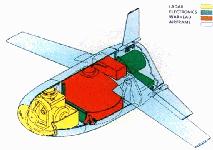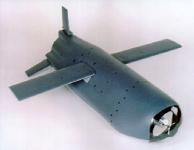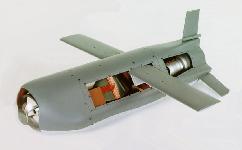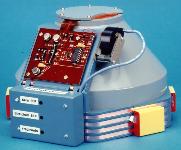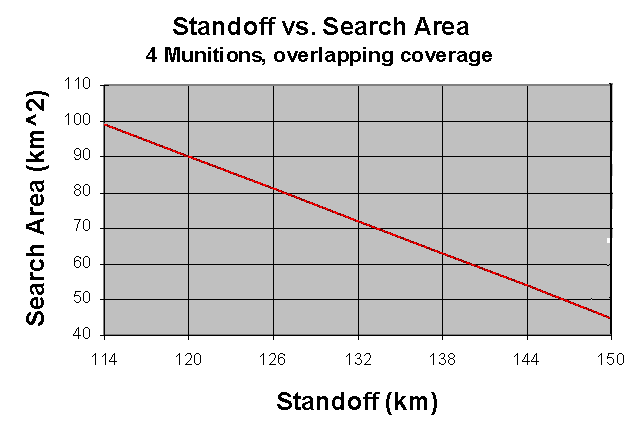



As of 07 January 1998 ACC approved a new acquisition strategy for the Small Bomb System (SBS) program. This strategy involves integrating the SBS on the F-22, F-22X and JSF and also includes combining the SBS and the Low Cost Autonomous Attack System (LOCAAS) efforts into a single program. This new program has been designated Miniature Munition Capability and has a planned start date for FY03. Implementation details of the new strategy are still being developed.
The LOCAAS is envisioned as a miniature, autonomous powered munition capable of broad area search, identification, and destruction of a range of mobile ground targets. LOCAAS is a low-cost LADAR sensor coupled with a multimode warhead and a maneuvering airframe to produce a high performance submunition. The warhead can be detonated as a long rod penetrator, an aerostable slug, or as fragments based on the hardness of the target. The LADAR allows target aimpoint and warhead selection to be determined automatically. The powered LOCAAS uses small turbojet engine which is capable of powering the vehicle for up to 30 minutes. Powered LOCAAS has a 33 sq. nm search area. On 17 December 1998 the Air Force Research Laboratory, Eglin AFB awarded Lockheed Martin of Dallas TX a $32,942,000 Other-Transaction-for-Prototype contract to provide for the Powered Low Cost Autonomous Attack Submunition (P-LOCAAS) advanced technology demonstration.This program includes system design, concept definition, fabrication and test of a LOCAAS prototype. An Other Transaction is a special acquisition method to develop prototype projects for which most procurement laws and the Federal Acquisition Regulation do not apply, thus allowing greater flexibility in meeting government requirements. Expected contract completion date is 10 December 2001.The Munition Directorate Assessment and Demonstrations Division of the Air Force Research Laboratory (AFRL) planned to pursue a procurement of an Advanced Technology Demonstration (ATD) program for the Powered Low Cost Autonomous Attack System (LOCAAS). The anticipated contract value of this effort is $12-14M between FY99-02. The purpose of the ATD is to demonstrate that a low cost, [NTE $30K average unit production cost (AUPC), not including the cost of dispensers/dispensing mechanisms], system can be produced using a Multi-Mode Warhead, solid state Laser Radar (LADAR) seeker with Autonomous Target Recognition (ATR), and INS/GPS midcourse guidance and that these components can be integrated into an air vehicle powered by a miniature turbojet engine.
The overall objective of the ATD is to provide an affordable standoff (minimum 90 miles) miniature munition to autonomously search for, detect, identify, attack, and destroy theater missile defense, surface-to-air missile (SAM) systems (i.e. SEAD) and interdiction/armor targets of military interest. The system will be capable of discriminating between classes/types of targets and between targets and non-combatants. The Powered LOCAAS system will be designed so as to be produced for less than $30,000 AUPC based on production of 12,000 units in 1994 base year dollars.
The basic strategy contemplated for the ATD is a four phased program. Phase I may consist of no more than two fully qualified contractors competing for downselect. This is a 6-12 month effort consisting of three main tasks. (1) Concept Definition: Which consists of a complete requirements flow down for entire munition system and address all munition performance requirements as well as mission planning dispense/delivery concepts. (2) System Design: A Detailed design for the entire munition, to include tactical safe/arm device (or function) and warhead interface. Munition design must be compatible with TMD (SUU-64, 66, 4 LOCAAS/TMD) dispense and be form/fit compatible with ATACMS and MLRS. In order to verify a dispensable design, sufficient level details must be provided for the TMD dispense system. (3) Preliminary Seeker Captive Test: Operate a tactical seeker testbed in accordance with the concept definition and system design. All proposed scan modes and decision logic must be implemented in both hardware and software (including ATR). The ability to autonomously identify targets in all three target groups (Attack Ops, SEAD, Armor/Interdiction) must be demonstrated. The ATR must be demonstrated in real time operation using a representative flight processor.Phase II is a 2-year effort that will consist of three major tasks. (1) Tactical Seeker Fabrication & Qualification: Fabricate a form factored seeker for captive flight test. Seeker optics and gimbals should be essentially identical to those fabricated for flight test, with the exception of any modifications necessary to ensure extended use under captive flight test. (2) KHILS Seeker Fab & Installation Support: Fabricate tactical seeker (for delivery to AFRL’s KHILS facility) will include mass balance gimbals/gimbal control system, PCE board, and flight processor (optical elements will consist of mass balance mockups). (3) Tactical Seeker captive Test: Test will demonstrate performance of seeker under full range of tactical scenarios. A minimum of three, 4-week test sequences in different geographical locations will be conducted, covering the full spectrum of LOCAAS targets and background settings. Performance vs. Known (deployed or soon to be deployed) countermeasure will be evaluated. Specific exit criteria will be established for selected missions and the LADAR/ATR performance will be judged against these criteria.
Phase III is a 2-year 6-month effort to be run in parallel with Phase II. This phase will consist of 2 major tasks. (1) Tactical Munition Fabrication: Fabricate flight test articles to support a control flight test and three powered, guided flight tests with inert warheads. Sufficient number of warheads shall be fabricated to demonstrate tactical level performance, including end-to-end fire train. (2) Tactical Munition Qualification: Qualification test for entire range of test environments.Phase IV is the culmination of Phases I - III and shall conduct up to four guided flight tests as discussed above.

Specifications | |
| Length | 30” |
| Wingspan | 40” |
| Box size | 8”x10” |
| Weight | 90-100 lbs |
| Engine | 30 - 50 lb thrust class turbojet |
| Endurance | 30 min expected |
| Range | > 100 km |
| Guidance |
INS/GPS midcourse guidance
Solid State LADAR Seeker
|
| Warhead |
Multi-mode Warhead
|
| Max aircraft loadout |
F-16 4 SUU-64 / 16 LOCAAS F-15E 5 SUU-64 / 20 LOCAAS F-22 2 LODIS / 16 LOCAAS JSF 2 LODIS / 16 LOCAAS B-52 16 SUU-64 / 64 LOCAAS B-1 30 SUU-64 / 120 LOCAAS B-2 16 LODIS / 192 LOCAAS |
| Cost goal | $33K Unit Production Cost (FY98$, 12,000 unit buy) |
